|
 |
 |
| |
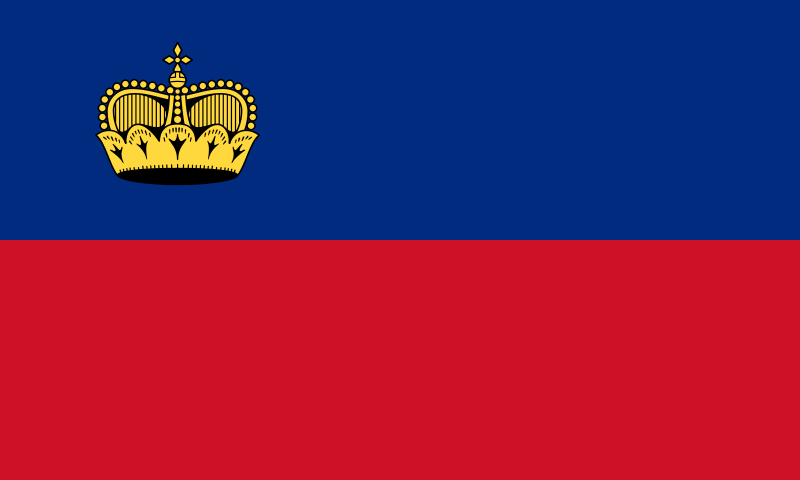 |
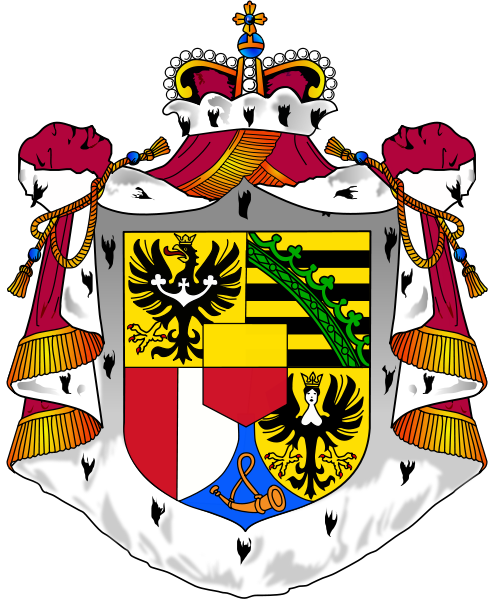 |
| |
| |
1230 County of Vaduz (Grafschaft Vaduz); part of
County of
Sargans
c.1276 Lordship of Schellenberg (Herrschaft
Schellenberg).
22 Jul 1396 City of Vaduz immediate within the Holy
Roman Empire.
1405 - 1408 Appenzell occupies Schellenberg.
1684 - 18 Feb 1686 Vaduz under imperial administration.
18 Jan 1699 Lordship of Schellenberg purchased by the Liechtenstein
dynasty.
22 Feb 1712 County of Vaduz purchased by the Liechtenstein family.
23 Jan 1719 County of Vaduz and Lordship of Schellenberg united as
Principality of Liechtenstein (Fürstentum Liechtenstein).
1794 - 1796
Imperial (Austrian) occupation.
06 Mar 1799 - 23 Mar 1799 French occupation.
12 Jul 1806 Established independence from the Holy Roman Empire.
05 Oct 1921 Constitution
1938 Prince Franz Josef II moves from Vienna to Vaduz,
becoming first prince to live in Liechtenstein.
24 Mar 1939 Failed Nazi coup led by Theodor Schädler.
30 Jun 1982 Current flag adopted |
| |
|
 |
| |
Liechtenstein,
officially the Principality of Liechtenstein (German: Fürstentum
Liechtenstein) is a doubly landlocked alpine country in Central Europe,
bordered by Switzerland to the west and south and by Austria to the east and
north. Its area is just over 160 square kilometres (61 sq mi).
Capital:
Vaduz. The biggest
town is Schaan. Liechtenstein has the highest gross domestic product per
person in the world when adjusted by purchasing power parity, and has the
world's lowest external debt. Liechtenstein also has the second lowest
unemployment rate in the world at 1.5% after Monaco. Motto:
"Für Gott, Fürst und Vaterland" ("For God, Prince and Fatherland").
The principality of Liechtenstein comprises two mediaeval lordships, that of
Vaduz and Schellenberg. The family is of ancient Bohemian extraction. They
long served Austria and the Empire and were raised to the status of Princes
of the Holy Roman Empire in 1608. John Adam I (d. 1712), one of these
earlier Princes, acquired the two lordships from the Hohenems family in 1699
(Schellenberg) and 1712 (Vaduz). His successor, Anthony Florian, was granted
these territories as a hereditary and sovereign Principality in 1719. It is
possible to argue, albeit somewhat whimsically, that as Liechtenstein is the
sole surviving state established exclusively as a creation of the Holy Roman
Empire, that through it, the Empire continues to exist de jure within these
61 square miles of Alpine scenery. This tiny principality abolished its army
in 1868 and has avoided involvement in all European war since that time. |
| Territorial
Dispute: None; In Feb 2005, the ICJ refused to
rule on the restitution of Liechtenstein's land and property assets in the
Czech Republic confiscated in 1945 as German property. This included over
1,600 km2 (618 sq mi) of agricultural and forest land, and several family
castles and palaces. Citizens of Liechtenstein were forbidden to enter
Czechoslovakia during the Cold War. More recently the diplomatic conflict
revolving around the controversial post-war Beneš decrees resulted in
Liechtenstein not sharing international relations with the Czech Republic or
Slovakia. Diplomatic relations were established between Liechtenstein and
the Czech Republic on 13 July 2009 and with Slovakia on 09 December 2009. |
| |
| |
- COUNTY of VADUZ
- SCHELLENBERG
- Marquard
I...............................................fl. c. 1267 with...
- Heinrich
I...............................................fl. c. 1267
- Marquard
II..............................................fl. c. 1300
-
Ulrich...................................................fl. c. 1300
- Schwigger................................................fl.
c. 1303 with...
- Marquard
III.............................................fl. c. 1303 and...
- Heinrich
II..............................................fl. c. 1303
- Heinrich
III.............................................fl. c. 1318 with...
- Egilolf..................................................fl.
c. 1318
- Heinrich
IV......................................... ? - 1342 with...
-
Albrecht............................................ ? - 1342
- WERDENBERG -
Counts of Vaduz and Lords of
Schellenberg (title Graf
von Vaduz und Herr zu Schellenberg)
- Hartmann
III...............................03 May 1342 - 1354
- Rudolf
IV.........................................1354 - 1367
with...
- Heinrich
VII......................................1354 - 1397
and...
- Hartmann
IV.......................................1354 - 06 Sep 1416
and...
- Hugo
IX...........................................1397 - 1416
and...
- Feihrr von Brandis
(pledge count).................1396 - 1416
and...
- Wolfhard
I........................................1416 - 1418
and...
- BRANDIS
- Wolfhard
II.......................................1418 - 1456
- Wolfhard III "Wölfi"..............................1456
- 09 Oct 1477
- Ulrich
II..................................09 Oct 1477 - 20 Aug 1486
-
Ludwig.....................................20 Aug 1486 - 06 Feb 1504
- Sigmund (regent)......................13
Feb 1499 - Oct 1499
- Sigmund (continued)........................06
Feb 1504 - 18 Nov 1507
- SULZ
-
Johann.....................................18 Nov 1507 - 1510 with...
- Rudolf
V...................................18 Nov 1507 - 1535
- Johann Ludwig
I...................................1535 - 1566
-
Wilhelm...........................................1566 - 1569 with...
- Alwig
XI..........................................1566 - 04 Jan 1572
- Rudolf
VIII.......................................1572 - 1602
- Hans Karl
Ludwig..................................1602 - 23 Mar 1613 d. 1617
- HOHENEMS
- Kaspar.....................................23
Mar 1613 - 10 Sep 1640
- Jakob Hannibal
II..........................10 Sep 1640 - 10 Apr 1645
- Franz Wilhelm
I............................10 Apr 1645 - 19 Sep 1662
- Ferdinand
Karl.............................19 Sep 1662 - 1684 with...
-
Karl Friedrich
(regent)...............19
Sep 1662 - 29 Dec 1671
-
Ruprecht II von Bodnau, Abbot of
Kempten..........1684 - 18 Feb 1686
- He was Imperial Comissioner.
- Jakob Hannibal III
Friedrich...............18 Feb 1686 - 22 Feb 1712 d. 1730
- From 18 Jan 1699, He was Count of Vaduz only.
-
Johann Adam I
Andreas......................18 Jan 1699 - 16 Jun 1712
- To 22 Feb 1712, Lord of Schellenberg only.
-
Joseph Wenzel
Lorenz S/o Philip Erasmus....17 Jun 1712 - 12 Mar 1718
- Joseph managed to rule Liechtenstein three
times. Firstly, in his own right, from 1712–1718. The second time, he
ruled as heir to Josef Johann Adam between 1732–1745 and the third time
as representative of the House of Liechtenstein from 1748–1772. He was
the 698th Knight of the Order of the Golden Fleece in Austria.
-
Anton Florian
S/o Hartmann III
............12
Mar 1718 - 23 Jan 1719
- The title of Hohenems-Vaduz persisted in
purely nominal form until the extinction of that branch of the
- family in 1766.
- PRINCIPALITY of LIECHTENSTEIN
- LIECHTENSTEIN
- The territorial Principality of Liechtenstein
received imperial recognition on 23 Jan 1719. The title Prince of
Liechtenstein (derived not from the territory but from Liechtenstein
Castle near Vienna) was granted earlier, but only as a personal
distinction. The rulers of the Liechtenstein family lived mainly in
Lower Austria and Moravia until moving permanently to Liechtenstein only
in 1938.
- Anton Florian
S/o Hartmann
III (continued).23
Jan 1719 - 11 Oct 1721
- He was born in Wilfersdorf, in what is now
Lower Austria. During the War of the Spanish Succession, he went to
Spain, where he was the Chief Intendant and Prime Minister of the
Archduke Karl, who became Emperor Charles VI after the sudden death of
his brother in 1711. Florian returned to Vienna for Charles's
coronation. He was the Imperial Chief Intendant and Chairman of the
Secret Council until he died in 1721. In 1719, Charles VI created the
new principality of Liechtenstein from the domains of Schellenberg and
Vaduz, which were both held by the Liechtenstein family. This was done
so that Anton Florian could be admitted to the Reichstag, which required
that all members had land that was subordinate only to the Emperor
himself (as opposed to land held in fief by higher nobles). Thus, Anton
Florian became the first Prince of Liechtenstein. It and Luxembourg are
the only states of the Holy Roman Empire that still exist. He was the
591st Knight of the Order of the Golden Fleece in Austria. He died in
Vienna in 1721.
- Joseph Johann
Adam S/o Anton Florian.......11 Oct 1721 - 17 Dec 1732
- Johann Josef Adam was the only son of his
father. He served under his father for a short time during the War of
the Spanish Succession and later fought against the French under the
Duke of Marlborough. After the Treaty of Utrecht he became Imperial
Privy Counsellor in Vienna. He was the 661st Knight of the Order of the
Golden Fleece in Austria. He died in Valtice in 1732.
- Johann Nepomuk
Karl S/o Joseph Johann
Adam.17 Dec 1732 - 22 Dec 1748
- When his father died, Johann Nepomuk Karl was
only eight and his relative Josef Wenzel ruled as regent. Nepomuk Karl
came of age in 1745 and thus took control of Liechtenstein's affairs. In
1744 he had married Maria Josepha, Countess of Harrach-Rohrau (20
November 1727 – 15 February 1788), daughter of Count Friedrich August
von Harrach-Rohrau. The couple had two daughters; Marianne (1745–1752)
and Maria Antonia (13 June 1749 – 28 May 1813). Johann Nepomuk died in
Wischau three years later at the age of 24 leaving no male descendants.
- Joseph Wenzel
Lorenz (regent).........17
Dec 1732 - 08 Jul 1745
- Joseph Wenzel
Lorenz (2nd
time)............22 Dec 1748 - 10 Feb 1772
- Franz Joseph
I S/o Emanuel.................10 Feb 1772 - 18 Aug 1781
- Franz Josef was the eldest of their thirteen
children. He was a nephew of Joseph Wenzel I, whom he succeeded on 10
February 1772. Franz Joseph had been recognised heir to Liechtenstein
since 1723, when his uncle's only son had died. Joseph Wenzel took Franz
Joseph under his wing and Franz Joseph accompanied him in a campaign in
Northern Italy, fighting with Wenzel at the Battle of Piacenza. The
battle was a victory for the Holy Roman Empire, of which Liechtenstein
was a part. He was the 802nd Knight of the Order of the Golden Fleece in
Austria. In 1763, Franz Josef traveled on behalf of the Emperor to
Spain, to bring the bride of Archduke Leopold a picture of the Archduke.
In 1767, he became Privy Councillor, and in 1771, he received the Order
of the Golden Fleece. Once Franz Joseph became Prince of Liechtenstein,
he showed great interest in its economic problems and the
ever-increasing Liechtenstein art collection. He died in Metz in 1781.
- Aloysius I [Alois
I] S/o Franz Joseph
I....18 Aug 1781 - 24 Mar 1805
- He was the third son of Franz Josef I. Aloys
was enlisted in the military as a youth but withdrew due to poor health.
His great interest was forestry and gardening and had many trees from
overseas planted around his manors for both economic and aesthetic
reasons. He also decorated Eisgrub Park with ornamental buildings. Aloys
I supported mining operations within his lands in Moravia in order to
raise money. This included the construction of an ironworks at Olomouc.
Aloys I also expanded the Liechtenstein library through the purchase of
complete collections of books. Aloys I had the architect Joseph
Hardtmuth design a new palace in Herrengasse, Vienna. He hired a
seasonal theater group and a permanent music group. During his reign,
Liechtenstein carried out the last execution in its history when Barbara
Erni was beheaded in Eschen for theft. He was the 836th Knight of the
Order of the Golden Fleece in Austria. Aloys married Karoline Gräfin von
Manderscheid-Blankenheim (Köln, 14 November 1768 - Vienna, 11 June 1831)
in Feldsberg on 15 November/16 November 1783. The couple was childless
and Liechtenstein went to Aloys' brother Johann I.
- Johann I (1st
time) S/o Franz Joseph
I.....24
Mar 1805 - 01 Aug 1806 d. 1836
- He was born Johann Baptist Joseph Adam Johann
Nepomuk Aloys Franz de Paula (26 June 1760 – 20 April 1836), was the
Prince of Liechtenstein between 1805 and 1806 and again from 1814 until
1836. He was the last Liechtenstein prince to rule under the Holy Roman
Empire between 1805 and 1806 and as regent of Liechtenstein from 1806
until 1814. He was the fourth son of Franz Joseph I, Prince of
Liechtenstein. Liechtenstein chose a military career at age 22 and
entered the army as a lieutenant in a cuirassier regiment. During the
Austro-Turkish War (1787-1791) he earned, in rapid succession, promotion
to Major, Oberstleutnant, and Oberst (colonel). He earned renown as a
good cavalry officer and was honored with the Knight's Cross of the
Military Order of Maria Theresa in 1790. During the French Revolutionary
Wars, Liechtenstein led 2,000 cavalry in an "outstandingly effective
cavalry action" at Avesnes-le-Sec on 12 September 1793. During this
battle he defeated 7,000 French troops, inflicting losses of 2,000
killed and wounded while losing only 69 men. In addition, 2,000 soldiers
and 20 artillery pieces were captured. He also participated in many
other battles. Soon after being promoted to General-Major in June 1794,
he fought at the Battle of Fleurus. He commanded a mixed
cavalry-infantry brigade in Anton Sztaray's division at the Battle of
Würzburg on 3 September 1796. After this action he was awarded the
Commander's Cross of the Order of Maria Theresa. In the War of the
Second Coalition, Liechtenstein commanded the Austrian Reserve at the
Battle of Trebbia. In August 1799 he received promotion to
Feldmarschal-Leutnant. He commanded 8,000 men in the successful siege of
Cuneo in November and December. On 3 December 1800, he led a 5,109-man
cavalry division in the Battle of Hohenlinden. As Prince of
Liechtenstein, Johann made forward-thinking reforms, but also had an
absolutist governing style. In 1818 he granted a constitution, although
it was limited in its nature. He expanded agriculture and forestry and
radically reorganized his administration, in an attempt to take the
requirements of what was then a modern estate into account. He proved a
trendsetter in the area of garden art by planting Biedermeier gardens
and park landscapes in an English model. In 1806 Napoleon incorporated
Liechtenstein in the Confederation of the Rhine and made it a sovereign
state. Liechtenstein was a member of the Rhine
Confederation from 1806 to 1815. At the Vienna Congress the sovereignty
of Liechtenstein was approved. Liechtenstein became a member of the
German Confederation in 1815. This membership confirmed Liechtenstein’s
sovereignty. He was the 869th Knight of the Order of the Golden Fleece
in Austria in 1806.
- Karl.......................................01 Aug 1806 - 07 Dec 1813 d.
1871
- Johann I S/o Franz Joseph
I (regent)..01
Aug 1806 - 07 Dec 1813
- Johann I (continued
as 2nd time)...........07
Dec 1813 - 20 Apr 1836
- Liechtenstein was a member of the German
Confederation from 1815 to 1866, when it became independent.
- Aloysius II [Alois
II] S/o Johann I........20 Apr 1836 - 12 Nov 1858
- Prince Aloys was born in Vienna as Aloys Maria
Joseph Johann Baptista Joachim Philipp Nerius (25 May/26 May 1796 – 12
November 1858) to Prince Johann I Joseph of Liechtenstein and
Landgravine Josepha of Fürstenberg-Weitra. His father was at the time of
his birth a Colonel in the Habsburg army, and since became a Field
Marshal before becoming the ruling Prince of Liechtenstein in 1805.
Aloys at the same time became the heir apparent. Alois contributed
actively to Liechtenstein's economic and political development.
- Johann
II S/o Aloysius II..................12 Nov 1858 - 11 Feb 1929
- Franz S/o Aloysius
II......................11 Feb 1929 - 25 Jul 1938
- He was born Franz de Paula Maria Karl August
(28 August 1853 – 25 July 1938), was the Prince of Liechtenstein between
1929 and 1938. He was the son of Aloys II of Liechtenstein and his wife
Countess Franziska Kinsky. Franz I served as the Austro-Hungarian
ambassador at the Court of Tsar Nicholas II in St. Petersburg between
1894 and 1899. As Prince of Liechtenstein, he continued the economic
reforms initiated by his brother. Franz I married Elisabeth von Gutmann
(Vienna, 8 January 1875 – Vitznau, 28 September 1947), a noblewoman of
Jewish descent, on 22 July 1929 in Vienna, without issue. He was the
1,204th Knight of the Order of the Golden Fleece in Austria. In March
1938 the elderly Franz I named Franz Joseph the country's regent.
Although he cited old age as his reason for relinquishing his duties, it
is widely believed that it was because he had no desire to be ruling if
Nazi Germany invaded his small Principality. Franz I died on 25 July
1938, and was formally succeeded by his first cousin.
- Franz Joseph
II (regent)..............30
Mar 1938 - 25 Jul 1938
- Franz Joseph II
S/o Aloysius (continued)...25
Jul 1938 - 13 Nov 1989
- Aloys Gonzaga Maria Adolf was the maternal
nephew and first cousin of Franz I of Liechtenstein, Prince Aloys
renounced his rights to the succession on 26 February 1923, in favor of
his son Franz Joseph II. He was the 1,177th Knight of the Order of the
Golden Fleece in Austria.
- Hans Adam II (regent).................26
Aug 1984 - 13 Nov 1989
- Hans Adam II S/o Franz Joseph II(continued)13
Nov 1989 - date
- Alois (regent)........................15
Aug 2004 - date
|
| |
| |
|
Monetary standard:
Swiss Franc = 100 rappen (centimes). |
| Liechtenstein
used the Austrian Krone and Heller until 1920, and switched to the Swiss
franc due to the krone's instability. In 1920,
Liechtenstein adopted the coinage of Switzerland and two years later entered
into a custom union with the Swiss, who also operated its postal and
telegraph systems and represented it in international affairs. Pegged with
Euro = at least 1.20 Swiss Francs. |
Coins were
produced in
- 1728 and 1729 by Joseph Johann Adam
- 1758 by Joseph Wenzel
- 1778 by Franz Joseph I
- 1862, 1898, 1900, 1904, 1910, 1915 and 1924 by Johann II
- 1930 by Franz
- 1946, 1952 1956, 1961 and 1988 by Franz Joseph II
- 1990 and 2006 by Hans Adam II
|
Liechtenstein coins are so rare that they
do not actually circulate, and no banknotes have been issued,
with the exception of 3 emergency issues of "Heller" in 1920.
Most of the Liechtenstein frank coins have the same amount of
precious metal as the Swiss franc, except for the coins minted
in the late 1980s and 1990s. The highest number of coins minted
was the 1 frank minted in 1924; 60,000 were struck, but 45,355
were melted. If the number of melted coins is excluded, the
highest mintage would be the 50 Franken minted in 1988
commemorating the 50th anniversary of the reign of Prince Franz
Joseph II and the 10 Franken minted in 1990 commemorating the
succession of Prince Hans-Adam II, both having a mintage of 35,000
pieces each.
|
| |
|
Coins by Johann II |
| |
| Currency:
1 Krone = 100 Heller (1900-1915). |
| |
|
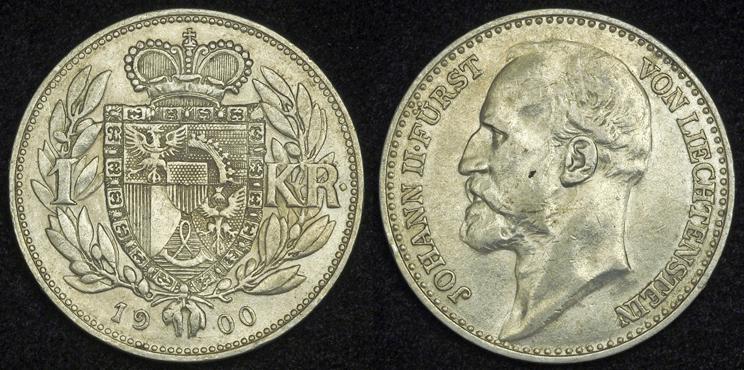 |
Y#2 1 Krone. Year:
1900. Weight:
4.94g [5.00g]. Metal:
0.835 Silver. Edge:
Lettering. Diameter:
23.00 mm.
Alignment:
Medal. Mint:
Vienna.
Obverse: Crowned shield of Liechtenstein,
within Order of the Golden Fleece chain and olive-wreath. "1"
numeral at the left side and "KR" on the right side. Date at the
bottom separately by mint mark.
Reverse: Head of Prince Johann II of
Liechtenstein facing left in the center. "JOHANN II FÜRST" written
left clockwise and "VON LIECHTENSTEIN" written right clockwise. Mintage:
50,000.
Minted Years: 1900, 1904,
1910 and 1915. |
|
 |
Edge Legend:
* ∞
* KLAR * UND * FEST *
∞ *
My coin has readable edge when
the head of Johann II side is on the top. |
|
 |
Y#3 2 Kronen. Year:
1915. Weight:
9.98g [10.00g]. Metal:
0.835 Silver. Edge:
Lettering. Diameter:
27.00 mm.
Alignment:
Medal. Mint:
Vienna.
Obverse: Crowned shield of Liechtenstein,
within Order of the Golden Fleece chain and olive-wreath. "2"
numeral at the left side and "KR" on the right side. Date at the
bottom separately by mint mark.
Reverse: Head of Prince Johann II of
Liechtenstein facing left in the center. "JOHANN II FÜRST" written
left clockwise and "VON LIECHTENSTEIN" written right clockwise. Mintage:
37,000.
Minted Years: 1912 and 1915. |
|
 |
Edge Legend:
* ∞
* KLAR * UND * FEST *
∞ *
My coin has readable edge when
the crowned shield/date side is on the top. |
| Note: Johann II, Prince
of Liechtenstein, born Johann Maria Franz Placidus (Eisgrub,
Moravia, 5 October 1840 – Valtice, 11 February 1929), aka Johann II
der Gute or Johann II the Good, was the Prince of Liechtenstein
between 1858 and 1929. His reign of 70 years, 3 months is the second
longest in European royal history after that of Louis XIV of France.
Johann II was the son of Aloys II, Prince of Liechtenstein and
Countess Franziska Kinsky. He ascended to the throne shortly after
his 18th birthday, and as such his reign is the longest precisely
documented tenure of any monarch since antiquity in which a regent
was never employed. In 1862, Johann II issued Liechtenstein's first
constitution. Later, after Liechtenstein left the German
confederation in 1866 and World War I, Johann II granted a new
constitution in 1921. It granted considerable political rights to
common Liechtensteiners, the latter making the principality a
constitutional monarchy. This constitution survives today but with
revisions, most notably in 2003. Liechtenstein left the German
Confederation in 1866. Not long after, the army of Liechtenstein was
abolished as it was regarded as an unnecessary expense. Johann II
somewhat cooled relations with Liechtenstein's traditional ally,
Austria-Hungary and its successor states, to forge closer relations
with Switzerland, particularly after World War I. Liechtenstein was
neutral during World War I but the war did break Liechtenstein's
alliance with Austria-Hungary and led it to go into a customs union
with Switzerland. Late in Johann's reign, in 1924 the Swiss franc
became Liechtenstein's official currency. Johann II added much to
the Liechtenstein Princely Collections. Although considered a
prominent patron of the arts and sciences during his long reign,
Johann II was also considered to be rather unsociable and did not
participate in social events. He never married or had any children,
like several other members of his family. Between 1905 - 1920,
Schloss Vaduz was renovated and expanded. Prince Johann II did not
live in the castle or even Liechtenstein, though his successors
would eventually move there in 1938. Schloss Vaduz would be their
home. He was the 987th Knight of the Order of the Golden Fleece in
Austria. Upon his death in 1929, Johann II was succeeded by his
brother Franz I. He was the
987th Knight of the Order of the Golden Fleece in Austria. Upon his
death in 1929, Johann II was succeeded by his brother Franz I. |
|
| |
|
Coins by Franz Joseph II |
| |
| Currency:
1 Frank = 100 Rappen (1924-date). |
| |
|
 |
| Y#20 10 Franken. Year:
1988. Weight:
29.95g. Metal:
0.900 Silver. Edge:
Reeded. Diameter:
37.00 mm.
Alignment:
Coin. Mint:
N/A.
Obverse: Franz Joseph II facing right in the
center. "FRANZ-JOSEF II. FÜRST VON LIECHTENSTEIN" (Franz Joseph II,
Prince of Liechtenstein) around him. Year at
the bottom. Designer name "MILAN" written below the his neck.
Reverse:
Denomination "10 FR" separated by Liechtenstein Coat and
Arms in the center. "FÜNFZIG JAHRE FÜRST VON LIECHTENSTEIN" (Fifty
Years Prince of Liechtenstein) around it. Small mint mark "FF"
joined together below the Coats And Arms. Mintage:
35,000.
Minted Years: One Year
Type. Note: Franz Joseph II,
Prince of Liechtenstein (16 August 1906 – 13 November 1989) was the
Sovereign Prince of Liechtenstein from 25 July 1938 until his death.
His full title: Franz Joseph Maria
Aloys Alfred Karl Johannes Heinrich Michael Georg Ignaz Benediktus
Gerhardus Majella, Fürst von und zu Liechtenstein, Herzog von
Troppau und Jägerndorf, Graf zu Rietberg.
He was the son of Prince Aloys of Liechtenstein and his wife
Archduchess Elisabeth of Austria (daughter of Archduke Karl Ludwig
and Infanta Maria Theresa of Portugal). He succeeded his childless
first cousin, Prince Franz I, after his father renounced his right
of succession in his favour in 1921. During his reign women received
voting rights for the first time, following a referendum on the
topic (among men only) in 1984. Franz Joseph was an extremely
popular sovereign in Liechtenstein. He was the first ruling prince
to live full-time in the principality. He also oversaw the economic
development of Liechtenstein from a poor agricultural backwater into
one of the richest countries (per capita) in the world. He was the
1,240th Knight of the Order of the Golden Fleece in Austria. Franz
Joseph handed over most of his powers to his son, Hans-Adam, in
1984. Franz Joseph II died on 13 November 1989, a mere twenty-six
days after his wife (Countess Georgine "Gina" Norberte Johanna
Franziska Antonie Marie Raphaela von Wilczek). Ruling Liechtenstein
for 51 years, he was the longest-ruling sovereign in Europe at the
time of his death. |
|
| |
|
Coins by Hans Adam II |
| |
|
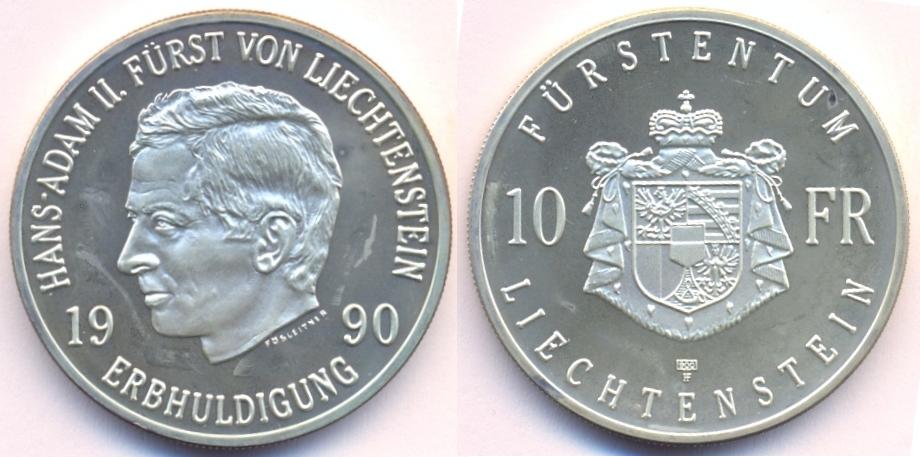 |
|
Y#22 10 Franken. Year:
1990. Weight:
29.95g. Metal:
0.900 Silver. Edge:
Reeded. Diameter:
37.00 mm.
Alignment:
Coin. Mint:
N/A.
Obverse: Hans Adam II facing left in the
center. "HANS-ADAM II. FÜRST VON LIECHTENSTEIN" (Hans Adam II,
Prince of Liechtenstein) written above him. Year divided on both
sides at the lower level. "ERBHULDIGUNG" (Hereditary Homage) written
at the bottom. Designer name "FÜSLEITHER" written below the his
neck.
Reverse:
"FÜRSTENTUM" (Principality) written at the top.
Denomination "10 FR" separated by Liechtenstein Coat and
Arms in the center. "LIECHTENSTEIN" written at the bottom. Small
"900" in rectangular box and "FF" joined together below it are seen
under the Coats And Arms. Mintage:
35,000.
Minted Years: One Year
Type. |
|
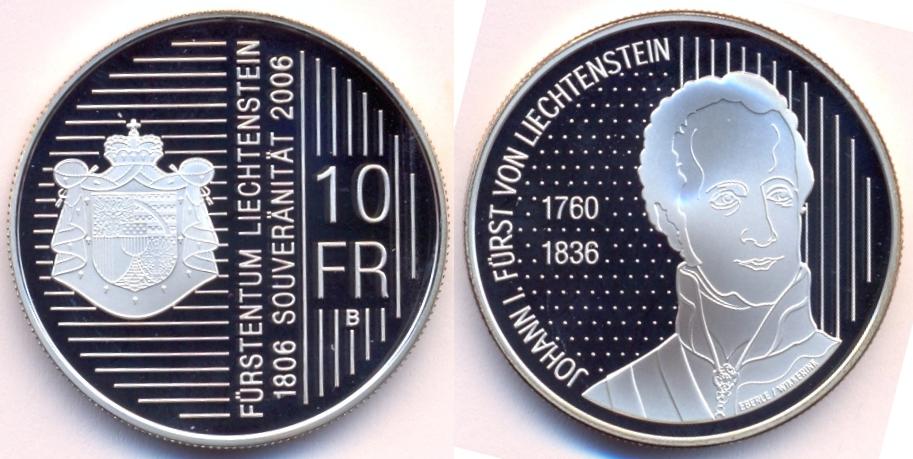 |
| Y#24 10 Franken. Year:
ND (2006). Weight:
29.95g. Metal:
0.900 Silver. Edge:
Reeded. Diameter:
37.30 mm.
Alignment:
Coin. Mint:
Bern.
Obverse: Liechtenstein's Coat and Arms on the
center left side with horizontal lines behind it. Vertical
inscriptions "FÜRSTENTUM LIECHTENSTEIN 1806 SOUVERÄNITÄT 2006"
(Principality of Liechtenstein 1806 Sovereignty 2006) between
crowned arms and value. Value "10 FR" surrounded by vertical lines.
Mint mark "B" below "FR".
Reverse:
Johann I portrait in the center right side. Years "1760" and "1836"
written on his left side. "JOHANN I. FÜRST VON LIECHTENSTEIN"
(Johann I, Prince of Liechtenstein) written clockwise on the left
side. Background is divided, having left side with dots and right
side with vertical lines.
Designer names "EBERLE / WIKKERINK"
written on his left chest.
Mintage: N/A.
Minted Years: One Year
Type. Subject:
200 Years of Sovereignty. Note:
Hans-Adam II [Johannes (Hans) Adam Ferdinand
Alois Josef Maria Marko d'Aviano Pius von und zu Liechtenstein, Duke
of Troppau and Jägerndorf, Count Rietberg], born 14 February
1945, is the reigning Prince of Liechtenstein. He is the son of
Franz Joseph II, Prince of Liechtenstein (1906–1989) and his wife
Countess Georgina von Wilczek (1921–1989). In 1969, Hans-Adam
graduated from the University of St. Gallen with a Licentiate
(equivalent to a Master's degree) in Business and Economic Studies.
He is the 1,305th Knight of the Order of the Golden Fleece in
Austria. On 30 July 1967, at Vaduz, Liechtenstein, he married his
second cousin, Countess Marie Aglaë Bonaventura Theresia Kinsky von
Wchinitz und Tettau (born 14 April 1940 in Prague). Prince Hans-Adam
owns LGT banking group and has a family fortune of $7.6 billion and
a personal fortune of about $4.0 billion, making him one of the
world's richest heads of state and Europe's wealthiest monarch. He
owns an extensive art collection, which is displayed for the public
at the Liechtenstein Museum in Vienna. In an interview, recorded in
November 2010, Hans-Adam said that he saw certain problems with
aspects of the U.S. Constitution, such as the lack of direct
democracy. He also said, "I am sitting here and that’s because
Americans saved us during World War II and during the Cold War. So I
am very grateful to them". |
|
| |
|
|
|
|
|
|
Countries
/ Territories |
| |
|
Chiefa Coins |
|
|











